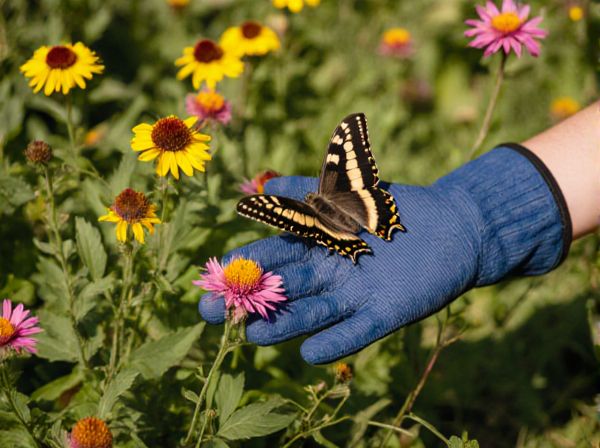
Moth-pollinated flowers vs Bat-pollinated flowers Illustration
Moth-pollinated flowers typically emit strong, sweet fragrances at night and have pale or white petals to attract nocturnal moths. In contrast, bat-pollinated flowers are often larger, more robust, and emit strong, musky odors while producing ample nectar to sustain bats during feeding. Both flower types have evolved specialized traits to optimize pollination by their respective nocturnal pollinators, ensuring successful reproductive cycles in low-light environments.
Table of Comparison
| Feature | Moth-Pollinated Flowers | Bat-Pollinated Flowers |
|---|---|---|
| Active Pollinator | Nocturnal moths | Nocturnal bats |
| Flower Color | White, pale, or dull colors | Strongly colored or white |
| Scent | Sweet, strong fragrance at night | Strong, musky odor |
| Flower Size | Small to medium | Large and sturdy |
| Nectar | Accessible, moderate volume | High nectar volume |
| Pollination Time | Nighttime | Nighttime |
| Examples | Jasmine, Evening primrose | Balsa tree, Banana flower |
Understanding Moth and Bat Pollination
Moth-pollinated flowers typically exhibit pale or white colors and emit strong, sweet fragrances at night to attract nocturnal moths using their long proboscises to access nectar deep within tubular corollas. Bat-pollinated flowers are often large, sturdy, and emit strong musky or fruity odors, producing copious amounts of nectar and featuring robust structures to support bats during pollination. Understanding the specific floral traits and sensory cues that attract moths versus bats enhances knowledge of nocturnal pollination strategies and ecosystem dynamics.
Key Characteristics of Moth-pollinated Flowers
Moth-pollinated flowers typically exhibit pale or white coloration to enhance visibility in low light and release strong, sweet fragrances during nighttime to attract nocturnal moths. These flowers often have long, narrow corolla tubes that accommodate moths' elongated proboscises, enabling efficient nectar access. Adaptations such as sturdy, exposed stamens ensure effective pollen transfer when moths probe for nectar under dim conditions.
Unique Traits of Bat-pollinated Flowers
Bat-pollinated flowers exhibit unique traits such as large, sturdy structures with pale or white colors that reflect moonlight, enhancing visibility at night. These flowers emit strong, musky, or fruity scents to attract bats using echolocation and keen olfactory senses. Unlike moth-pollinated flowers, bat-pollinated blooms produce copious amounts of nectar and pollen to sustain larger pollinators during nighttime feeding.
Flower Color and Scent: Moth vs Bat Attraction
Moth-pollinated flowers typically exhibit pale or white colors to stand out in low-light environments and emit a strong, sweet fragrance during the night to attract nocturnal moths. In contrast, bat-pollinated flowers often display dull, greenish or brownish hues with large, robust structures and release a musky or fruity scent to appeal to bats' keen olfactory senses. These distinct color and scent adaptations are crucial for effectively targeting their respective pollinators in the dark.
Nocturnal Pollinators: Ecological Roles
Moth-pollinated flowers often emit strong, sweet fragrances and display pale or white colors to attract nocturnal moths, which rely heavily on olfactory cues for navigation in low light. Bat-pollinated flowers typically have robust structures, emit musky or fermenting odors, and produce copious amounts of nectar to support the high energy demands of bats during nighttime foraging. Both moths and bats play crucial ecological roles in maintaining biodiversity by facilitating gene flow and reproduction in various nocturnal plant species.
Adaptations for Nighttime Pollination
Moth-pollinated flowers exhibit pale colors, strong sweet fragrances, and tubular shapes to attract moths during nighttime, enhancing scent dispersion in cooler air. Bat-pollinated flowers tend to be large, sturdy, and emit musky or fermented odors, with abundant nectar to support the bats' high energy needs during nocturnal foraging. Both flower types show specialized adaptations in timing nectar production to align with their respective pollinators' active nighttime periods.
Importance in Garden Biodiversity
Moth-pollinated flowers emit strong, sweet fragrances at night and often possess pale or white colors to attract nocturnal moths, playing a crucial role in supporting nighttime pollinator activity in gardens. Bat-pollinated flowers tend to be large, sturdy, and produce ample nectar, contributing to the sustenance of bat populations that facilitate pollination of various plants, especially in tropical and subtropical gardens. Both moth and bat pollination enhance garden biodiversity by supporting unique pollinator species, promoting diverse plant reproduction, and maintaining balanced ecosystem functions.
Popular Moth-pollinated Garden Plants
Popular moth-pollinated garden plants include evening primrose, nicotiana, and moonflower, known for their white or pale, fragrant blooms that attract nocturnal moths. These flowers emit strong, sweet scents at night, facilitating moth navigation and pollination. Unlike bat-pollinated flowers, which are typically larger and more robust to support bat visits, moth-pollinated plants tend to be more delicate and elongated to accommodate moth proboscises.
Common Bat-pollinated Flower Species
Common bat-pollinated flower species include the agave (Agave spp.), baobab (Adansonia spp.), and balsa tree (Ochroma pyramidale), all adapted to nocturnal pollination with large, pale, and heavily scented blooms. These flowers produce abundant, sugary nectar to attract bats and typically bloom at night, facilitating efficient pollen transfer by their primary pollinators. In contrast, moth-pollinated flowers tend to be smaller, with narrow tubes and subtle fragrances suited to the feeding habits of moths.
Tips for Attracting Moth and Bat Pollinators to Your Garden
Moth-pollinated flowers typically emit strong, sweet fragrances at night and feature pale or white colors to attract nocturnal moths, while bat-pollinated flowers are often large, sturdy, and emit fruity or musky scents with pale or dull colors suitable for bat sensory perception. To attract moth pollinators, plant night-blooming flowers such as evening primrose, jasmine, and nicotiana, ensuring a sheltered and humid garden environment that supports moth activity. For bat pollinators, integrate native flowering trees like baobabs, agaves, and cacti, provide water sources, and minimize artificial lighting to encourage bat visitation and effective pollination.
Moth-pollinated flowers vs Bat-pollinated flowers Infographic

 gardendif.com
gardendif.com